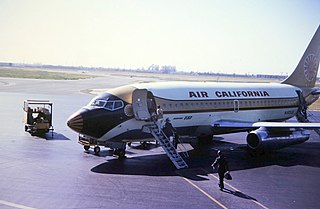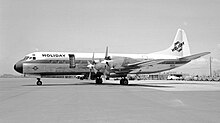
The Federal Aviation Administration (FAA) is a U.S. federal government agency within the U.S. Department of Transportation which regulates civil aviation in the United States and surrounding international waters. Its powers include air traffic control, certification of personnel and aircraft, setting standards for airports, and protection of U.S. assets during the launch or re-entry of commercial space vehicles, powers over neighboring international waters were delegated to the FAA by authority of the International Civil Aviation Organization.

The Airline Deregulation Act is a 1978 United States federal law that deregulated the airline industry in the United States, removing federal control over such areas as fares, routes, and market entry of new airlines. The act gradually phased out and disbanded the Civil Aeronautics Board (CAB), but the regulatory powers of the Federal Aviation Administration (FAA) were not diminished over all aspects of aviation safety.
Air Florida was an American low-cost carrier that operated under its own brand from 1972 to 1984. During the period from 1972 to 1978 Air Florida was an intrastate airline. Until a notorious 1982 aircraft crash in Washington DC, Air Florida was considered a high-profile early success of U.S. airline deregulation, having expanded rapidly from its original Florida network, including internationally to Europe and Latin America. After the crash, the airline struggled for over two and a half years before finally succumbing to bankruptcy in 1984.
Pacific Southwest Airlines (PSA) was a low-cost US airline headquartered in San Diego, California, that operated from 1949 to 1988. It was the first substantial scheduled discount airline. PSA called itself "The World's Friendliest Airline" and painted a smile on the nose of its airplanes, the PSA Grinningbirds. The Los Angeles Times called PSA "practically the unofficial flag carrier airline of California for almost forty years."

Air California, later renamed AirCal, was a U.S. airline company headquartered in Newport Beach, California that started in the 1960s as a California intrastate airline. The airline's home airport was Orange County Airport, now known as John Wayne Airport.
Airline deregulation is the process of removing government-imposed entry and price restrictions on airlines affecting, in particular, the carriers permitted to serve specific routes. In the United States, the term usually applies to the Airline Deregulation Act of 1978. A new form of regulation has been developed to some extent to deal with problems such as the allocation of the limited number of slots available at airports.
The Air Commerce Act of 1926 created an Aeronautic Branch of the United States Department of Commerce. Its functions included testing and licensing of pilots, certification of aircraft and investigation of accidents.

The Civil Aeronautics Board (CAB) was an agency of the federal government of the United States, formed in 1938 and abolished in 1985, that regulated aviation services and conducted air accident investigations. The agency was headquartered in Washington, D.C.

The Wright Amendment of 1979 was a United States federal law that governed traffic at Dallas Love Field, an airport in Dallas, Texas, to protect Dallas Fort Worth International Airport (DFW) from competition. The amendment—enacted in reaction to the refusal of Southwest Airlines to vacate Love Field and move to DFW—prohibited carriers from operating full-size airliners between Love Field and destinations beyond Texas and its four neighboring states. Further amendments in 1997 and 2005 added new states and relaxed aircraft rules for longer range service. The law was partially repealed in 2006 and then fully repealed in 2014.

The California Public Utilities Commission is a regulatory agency that regulates privately owned public utilities in the state of California, including electric power, telecommunications, natural gas and water companies. In addition, the CPUC regulates common carriers, including household goods movers, limousines, rideshare services, self-driving cars, and rail crossing safety. The CPUC has headquarters in the Civic Center district of San Francisco, and field offices in Los Angeles and Sacramento.

Trans Caribbean Airways (TCA) was an irregular air carrier until 1957, when it was certificated by the Civil Aeronautics Board (CAB) as an international air carrier to fly from New York City to San Juan, Puerto Rico. TCA thereafter operated as a small scheduled airline specializing in flying from New York to the Caribbean, adding a small number of additional routes over time until it was purchased by American Airlines in 1971.
Houston East & West Texas Railway Co. v. United States, 234 U.S. 342 (1914), also known as the Shreveport Rate Case, was a decision of the United States Supreme Court expanding the power of the Commerce Clause of the Constitution of the United States. Justice Hughes's majority opinion stated that the federal government's power to regulate interstate commerce also allowed it to regulate purely intrastate commerce in cases where control of the former was not possible without control of the latter. Because the Supreme Court consolidated several related appeals, they are sometimes collectively known as the "Shreveport Rate Cases" although the Supreme Court issued only one ruling.
George W. Bush & Sons Co. v. Malloy, 267 U.S. 317 (1925), was a decision by the United States Supreme Court, which held that the state statute under which the Maryland Public Service Commission (PSC) issued certificates of public convenience and necessity to common carriers engaged in interstate commerce violated the Commerce Clause of the United States Constitution.

Kenneth Giles Friedkin was an American aviator and businessman. He founded Pacific Southwest Airlines (PSA), generally viewed as the original low-cost airline. PSA was the acknowledged inspiration for Southwest Airlines, which in turn inspired low-cost airlines globally. Friedkin is therefore a key figure in the advent of low-cost air travel. In 2001, Forbes Magazine referred to Friedkin as "an early-model Herb Kelleher." Friedkin's son and grandson went on to even greater business success outside of aviation.

California Central Airlines (CCA) was a post-war American scheduled price-focused intrastate airline based at Burbank, California, the most prominent airline associated with Charles C. Sherman. CCA slightly preceded, and during its existence was bigger than, its contemporary and competitor, Pacific Southwest Airlines (PSA). The core route of both airlines was from Los Angeles to the San Francisco Bay Area.

Founded in 1967 to be a Texas intrastate airline, Southwest Airlines was initially prevented from operating, and saw long-haul flights from its original Dallas Love Field base restricted by federal law for several decades. Despite these obstacles, Southwest has built a history of innovative business practices, was a major source of inspiration for US airline deregulation and was probably the biggest beneficiary of deregulation, growing to be one of the largest airlines in the United States and one of the largest low-cost carriers worldwide.

Holiday Airlines was a California intrastate airline. Holiday operated scheduled passenger service with Lockheed Electra turboprops in California almost exclusively serving Lake Tahoe from Southern California and the San Francisco Bay Area during period 1965-1975. Holiday started roughly contemporaneously with Air California but the two airlines had different trajectories.
Transportation in the United States is governed by laws and regulations of the federal government. The Department of Transportation is responsible for carrying out federal transportation policy, and the Department of Homeland Security is responsible for security in transportation.
The Texas Aeronautics Commission (TAC) was a Texas government body established in 1945 by the Texas Aeronautics Act with a remit to promote and establish aviation within Texas, including assisting with the construction of airports and other aviation infrastructure. Amendments to the act in the 1960s increased the size of the commission from three to six commissioners and broadened its role to include, among other things, acquiring land for airports and the economic regulation of intrastate airlines operating within Texas. The TAC was reorganized out of existence in 1989.
M. Lamar Muse was an American airline executive. He is best known as establishing the foundations of the business model of Southwest Airlines as its first CEO (1971–1978) and as co-founder of an eponymous airline Muse Air (1980–1985).















